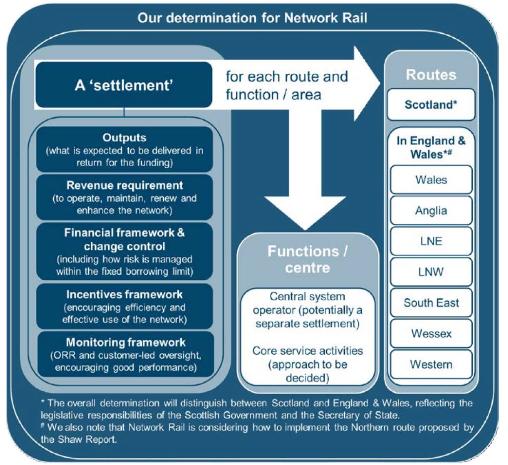This is the fourth in our series of articles on PR18, the Office of Rail and Road (ORR)'s periodic review of Network Rail.
Background so far on regulating system operation
The ORR started consulting in August 2015 on what system operation meant and in June 2016 they issued a response note setting out their revised understanding of what system operation is in rail and how it is undertaken by different parties.
They used this note to support two working papers issued on 7 June 2016: Working Paper 2 contained initial views on the potential issues and opportunities in system operation; and Working Paper 3 had initial views on the regulatory framework for Network Rail's system operator function.
Following this, on 17 November 2016 the ORR published a consultation on the development of the regulatory settlement for the Network Rail national system operator in CP6, together with a supporting document.
Finally, they published draft guidance on Network Rail's strategic business plans on 23 November 2016.
Defining system operation
System operation is about how Network Rail operates its rail network and how decisions by Network Rail and others are made about the use of this network and its expansion over time. Network Rail carries out much of this through its Network Strategy and Capacity Planning Directorate, which is referred to in the November 2016 consultation as the National System Operator or NSO.
System operation comprises long-term, medium-term and short-term system operation. It is not just Network Rail that is involved in system operation (the DfT, Transport Scotland and the ORR itself also play a part), but it is only Network Rail's system operation functions that the ORR regulates.
Long-term system operation relates to developing proposals for changes to the network and deciding which projects to take forward, including: strategic planning of the rail network, through Network Rail's long term planning processes (LTPP); and leading the production of market studies and route studies.
Medium-term system operation relates to determining the capacity of the physical network and understanding its potential use, as well as allocating that capacity. This includes: managing the Timetable Planning Rules (TPRs) and producing the working timetable on an annual or bi-annual basis; integrating new enhancements into the existing network; planning access that includes the sale of access rights, and providing a key interface between customer and stakeholders who need to use the network.
Short-term system operation is mainly about short-term capacity allocation and includes activities such as: accommodating requests for capacity outside of the timetabling process, e.g. in the freight spot market; and making decisions about which services to prioritise during disruption.
Some of these are done at route level, some from the centre. The ORR are looking at regulating the central activities separately; the local ones will come under route-level regulation.
Regulating system operation
In Working Paper 2, the ORR identified six outcomes of good system operation:
- continued safe operation
- getting more from the network
- making the right trade-offs
- the right services using the right network
- helping train operators to deliver
- choosing the right investment.
To date, the ORR's regulation and monitoring of Network Rail has not focused specifically on the NSO's activities, which has made it difficult for the ORR to assess the NSO's performance and to hold it to account. So Working Paper 3 considered ways in which the ORR could regulate in order to do this.
System Operator settlement
Working Paper 3 considered two issues:
- The case for a more focused approach to regulating the delivery of the system operator's functions and the scope of functions that could be captured in such an approach.
- The possible form of the system operator settlement, including how to determine its performance targets (outputs), incentives, costs, and reporting and monitoring for CP6.
As a reminder, this is how the ORR sees a settlement working, and it can be seen from this diagram that they have been considering a potential separate system operator settlement from the outset:

As a result of discussions with stakeholders about the Working Papers, the ORR have decided to have a separate system operator settlement, sitting alongside the settlement for the routes as part of Network Rail's wider determination. However, they will not be setting direct charges on operators for NSO services, consistent with their approach of simplifying the charging framework.
The aims of the separate NSO settlement and plan are to:
- Improve transparency of the NSO’s role so that funders, operators and the ORR are better informed about the decisions it makes, their impact and rationale. This could relate to, for example, its analysis on what enhancements should be taken forward and what they will deliver or what capacity is available for new operators;
- Sharpen the NSO’s incentives to manage the network more effectively, both in terms of optimising the performance of train services and improving the use of existing capacity (in the way it produces the timetable, for example); and
- Support longer-term investment in better data, processes and technology so that the NSO has the tools and capability to be a highly competent, proactive and creative system operator that delivers – and enables the rest of industry to deliver – the benefits of a coherent rail network.
The system operator settlement will need to look at: outputs; revenue requirement and the financial framework needed to meet them; the system operator's financial, reputational and management incentives; and monitoring and enforcement against the system operator functions (as set out in the diagram above).
Outputs
It is easier to set outputs for short-term system operation. Medium- and longer-term functions may have to have input-based measures.
Revenue requirement and financial framework
The ORR has decided to require Network Rail to report on both its operating costs and its capital expenditure on NSO activities. They are exploring whether an additional mechanism is needed to support capital expenditure or investment by the NSO, to encourage (or at the very least, not discourage) the NSO from undertaking longer-term investment. One of the options is to create a Regulatory Asset Base (RAB) for the NSO, although stakeholders did not support this.
Incentives
There is likely to be a baseline revenue allowance which could increase or decrease depending on performance.
Monitoring and enforcement
This will be done through Network Rail's licence. Any financial penalty would be reflected in the system operator's financial performance and the remuneration of its management.
Four issues to prioritise
In the supporting document issued with the November 2016 consultation, the ORR identified four issues to prioritise in relation to the NSO's activities, which it will seek to address as part of the NSO's regulatory framework for CP6:
- The incentives for the NSO when trading-off increased capacity use, performance and cost are not currently balanced, partly because there are no accurate measures of available system capacity. For example, Network Rail has in the past rejected some requests for extra capacity (for which it receives only a small increase in income) on the basis that they could affect performance (for which it is penalised).
- The NSO's activity of managing the TPRs and producing capacity studies to inform investment and capacity allocation decisions could be improved. They are not based on the most up-to-date inputs and assumptions.
- The NSO's production of the working timetable could be more effective at unlocking benefits (both in terms of capacity use and performance). At the moment, it just builds on the existing timetable rather than taking a holistic approach.
- The alignment of incentives between the NSO, Network Rail in general and operators in relation to operational performance could be improved. The Public Performance Measure (PPM) and Cancellations and Significant Lateness metrics are per train, not per passenger, for example.
Measuring the System Operator's performance
Network Rail started a programme, 'SO Fit for the Future', in June 2016, intended to go live in June 2017. The aims are to provide a clear vision for the NSO, create a NSO function within Network Rail and consider in more detail its role as a 'client' for enhancement projects so that, on behalf of funders and routes, it ensures the enhancement programme is delivered in line with the agreed plans.
Network Rail is also developing a scorecard for the NSO for CP6 and will be having formal discussions with its customers during 2017 about this.
The ORR have produced a table of initial ideas for ways to measure the NSO's operational performance (see Table 2.1 in the November 2016 consultation). They may not all be regulated outputs, but could form part of a scorecard or the ORR's routine monitoring and reporting on the NSO's performance.
Next steps
Network Rail will produce a discrete strategic plan for the NSO business unit in autumn 2017 setting out its priorities for CP6, demonstrating how it has engaged with stakeholders to understand and address their priorities, and explaining what revenue it needs to meet its outputs efficiently. The ORR has produced draft guidance to help Network Rail produce all its strategic plans, with the final guidance due in February 2017.





